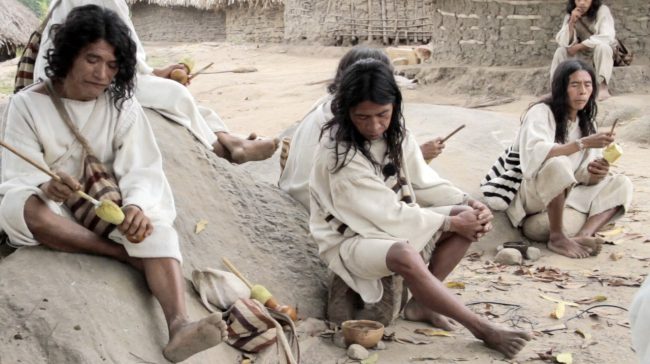A Workshop in the Sierra Nevada de Santa Marta, Colombia.
“(the poet) it is him who, despite the thorns, the envy and derision, walks hunched among the ruins gathering the tradition. Fertile tradition springs from everything that covers the earth, everything that the heavens can bless. Every idea, human or divine, which takes the past as a root, bears the foliage of the future.” Victor Hugo. Rays and Shadows
“… one doesn’t invent magic formulas, as one doesn’t invent true poetry, but they are born from blood and light. This is why, in general, sacred magic uses traditional formulas; not because they are ancient but rather because they were born in this way, and therefore are magic.” Anonymous. Meditations on the 22 Arcana of the Tarot.
Theoretical considerations
The shamans from many different tribes around the Americas are embarking on a conscious journey to meet us ‘Whites’ establishing a true dialogue on their laws and paths to health and healing, and on what we could term their Art of living. These indigenous "wisdom keepers" are offering us ways of shedding light on a mechanistic, exclusively intellectual mode of thinking, and to lead us towards a holographic world view that entails alternative relationships with the body and with the sensible world.
On the side of 'white' doctors there is currently an effort of synthesis between these traditional approaches to healing and our modern medicine. Within all of these traditions there is a matrix of balance, a science of equilibrium that our Western civilization has slowly forgotten. This disconnection is placing us increasingly at risk. These so-called indigenous people are also at risk since they are slowly loosing their traditions without there being a real upgrade to the contemporary reality that touches them in every sense. The point is not preservation of traditions but the actualization of patterns of thought conducive to reconnection. If mythical thought in today’s world is to live on it is in the guise of a métissage, (a cross breeding) that reignites the seeds of this kind of consciousness, in new dimensions within our society.
By means of an intense exchange, by experiencing other cultures’ cosmovisions it is possible to develop an understanding and create fruitful synthesis that lead to the reconsideration of the human being in this Age. Mythic thought is a very powerful engine to envision artistic practice sub specie eternitas, under the guise of timelessness.
The term "Anthropocene" initially sprung from the field of geology to describe a world where human influence is all encompassing, where there is no longer an environment devoid of human intervention, be that by pure neglect or by technological modeling. Addressing this term frontally we might be led to understand that now that 'mass extinction' is no longer a word solely for the dinosaurs it might be time to imagine who the human being is, and to project images that might lead us to think what has been left un-thought since we embarked in the space ship of modernity and the so called industrial revolution. It is an urgent task, and this imagination of "who the human being might be" is a task calling precisely for the activation of artists and philosophers.
The narrow Western intellectual worldview sees what we call "currents of thought", the indigenous mind is, on the other hand tuned to experience, and its thought is bound to that experience. Healing and art in the indigenous world are linked to experience, the patient is stimulated to go through a healing experience and the healing experience is a reconnection with the creative matrix, through the Image, and through the Word. The foundations of Western medicine show us that this was present in our pre-pfizer origin, as much as we might be unaware of it. Iatromantis is a Greek word whose literal meaning is most simply rendered "physician-seer," or "medicine-man". The iatromantis, a healer-prophet, used a technique called incubation (ἐγκοίμησις, enkoimesis). More than just a medical technique, incubation allowed a human being to experience a fourth state of consciousness different from sleeping, dreaming, or ordinary waking: a state described as “consciousness itself”. Again, if anyone has the tools for digging up the present tense out of these terms and bringing them to task in our contemporary world it is, in my opinion the artist and the philosopher.
Enhanced awareness, the basis of ritual is the opposite to what happens during our normal daily activity; we are relatively “absent” from ourselves, in the sense that we are unaware of our whole functioning in terms of interrelations between cognitive, motor, sensory and emotional responses. In this way a comprehensive ethics arises in which well-being is supported by clarity of thought, the way it is reflected in the body and the extent to which behaviors positively influence a society. This offers the possibility of opening the individual, the body, the emotions, the “soul”, society and the world in a single act, through the transformation of our main Western tools: the Word and the Image. Naïkïno is the term for the word-body that works both “vertically”, as it interprets experience in terms of the origin myths, and “horizontally”, by means of analogies. It is here again that this whole endeavor links the practice of a medicine man with that of the artist.
To see “beyond”, hear “beyond” and talk “beyond” the world of appearances: If we only consider the superficial layer of reality, we loose sight of the engine that Ars has at its core. This kind of “sight” enables us to feel the subtle energy field of people, their emotions and motivations, and that is exactly the ground on which the ritual conversation takes place. The person who directs the ritual tunes into a subliminal current of information, which is impressed on their mind while the myths are related and questions about personal and interpersonal matters are discussed, the word and the image arise from here.
